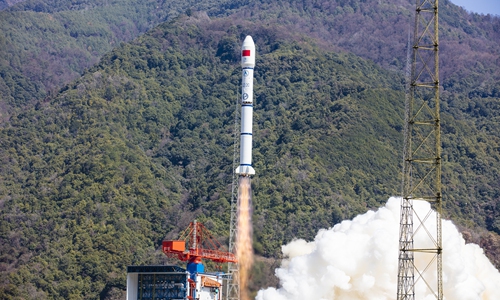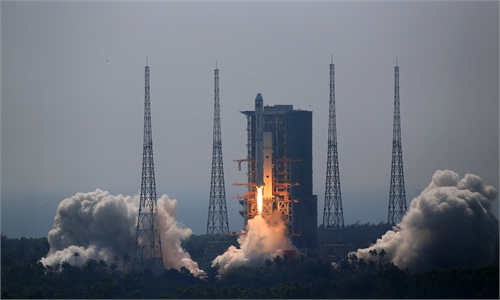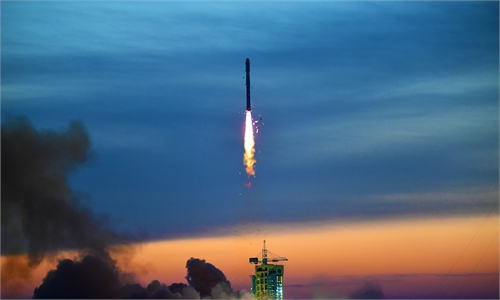Chinese firm forges nation's first low-Earth orbit broadband communication test constellation

A Long March-2C carrier rocket carrying six satellites produced by GalaxySpace and a commercial remote sensing satellite blasts off from the Xichang Satellite Launch Center in Southwest China's Sichuan Province on March 5, 2022. Photo: Courtesy of GalaxySpace
Chinese companies sent seven satellites into space from the Xichang Satellite Launch Center in Southwest China's Sichuan Province on Saturday, aiming to build the nation's first low-Earth orbit (LEO) broadband communication test constellation.
Six satellites were produced by Beijing-based start-up GalaxySpace and a commercial remote sensing satellite was launched by a Long March-2C carrier rocket and entered their planned orbits.
The successful mission proved that China has built up the low-cost, batch development and networking operation capabilities of satellites, all factors that are necessary to build a satellite internet mega-constellation.
The six broadband communication satellites will form China's first LEO broadband communication test constellation together with the first satellite of GalaxySpace, and build a satellite-ground fusion 5G test network, codenamed "Mini-spider Constellation," capable of providing communication services for more than 30 minutes each time.
The six satellites, with an average weight of 190 kilograms, have a communication capacity of more than 40 gigabytes per second (Gbps) each.
The development cost of a single satellite has been reduced to half of the firm's first satellite, according to the firm.
GalaxySpace launched China's first LEO broadband private communications satellite on January 16, 2020.
With the iteration of technology and improvements in industrial batch production capacity, the unit prices of satellites can drop rapidly, and the commercial value of domestic satellite internet has bright prospects, industry analysts said.
The satellites will verify the networking technology and service capability of the LEO internet constellation. They will also verify remote-sensing technology, which will mark the start of verification and application of communication and remote-sensing integrated technologies for LEO satellites.
The ground data processing system was developed independently by Beijing Four Squares Technology, a satellite data analysis company.
Xi Xiaofei, founder and CEO of the company, told the Global Times that there was no precedent in the industry for LEO satellites to carry both remote sensing payloads and communication payloads at the same time.
Applications in the two systems are usually independent, playing a pivotal role in each of their domains without forming a whole, and the efficiency of information acquisition and utilization is still low.
"The strategic position of LEO remote-sensing satellites has become increasingly prominent. As the accuracy of satellites continues to improve, the raw data grows exponentially. At the same time, remote sensing, as an important factor in scenarios such as emergency rescue and disaster relief, maritime monitoring and global target monitoring, needs to achieve minute-level response," Xi said.
Remote sensing and communication integration, combined with intelligent ground-data processing systems, will accelerate emergency responses.
Demand for China's domestic commercial launches has been growing rapidly in recent years. Due to the low technology threshold, LEO satellites are becoming the main development direction of commercial satellites, and the market size continues to expand, Jiang Jie, a rocket expert with the China Academy of Launch Vehicle Technology, said at the sidelines of the two sessions, which kicked off in Beijing on Friday.
Satellite internet, which uses satellites to provide high-speed internet services even in hard-to-reach rural areas, has emerged as a key driving force for the world economy.
Morgan Stanley has estimated that the global space industry will generate revenue of $1 trillion in 2040, about 50-70 percent from satellite internet.
China's constellation is small compared with Starlink, owned by Elon Musk's firm SpaceX, which already has more than 2,000 satellites in orbit. But China is ramping up efforts to promote the application and transfer of space technology in the next five years, according to a white paper on the country's space program issued in January.
China will accelerate the integration of satellite applications with the development of industries and regions and space information, using new-generation information technology such as big data and the Internet of Things, the white paper said.
The country will extend the integrated application of remote-sensing satellite data on land, at sea and in the atmosphere.
The National Development and Reform Commission included "satellite internet" among its new infrastructure initiatives for the first time on April 20.
According to a forecast by GalaxySpace founder and CEO Xu Ming, there will be at least two global satellite internet companies in the future, one of which will be Starlink, and the other will be from China.



